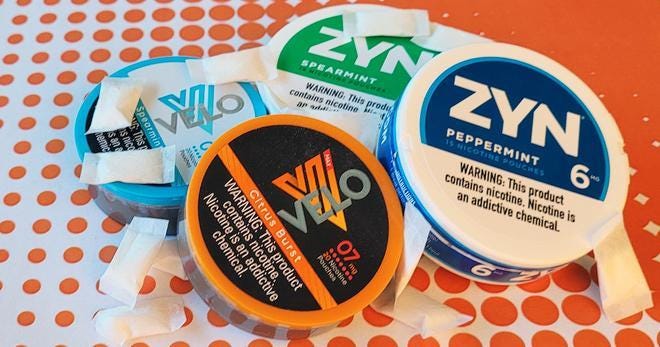What are nicotine pouches, and what are their risks for teens?
TL;DR: Nicotine pouches are small, flavored microfiber pouches that deliver nicotine through the mouth and gums. As with any nicotine product, they are highly addictive and come with potential risks for developing teen brains. Trusted adults can help.
As a millennial who grew up in Virginia’s “tobacco country” in the 90s and early 2000s, I was always around tobacco. My relatives were tobacco farmers, my parents and grandparents smoked cigarettes, and many of my friends started smoking in their teens. Since then, cigarette smoking among teens has been on the decline, thanks to mass media campaigns and policies aimed at protecting youth from nicotine addiction and tobacco-related health problems.
But then came e-cigarettes and vapes, attracting the next generation of nicotine users. Since most e-cigarettes and vapes have nicotine, they pose potential risks to youth whose brains are still developing until about age 25. Animal research suggests that nicotine can harm the parts of the developing brain that control attention, learning, and impulse control. Even though vapes are still the most used tobacco-related product among young people by far, vaping is at its lowest level in a decade, according to the Food & Drug Administration’s 2024 National Youth Tobacco Survey report published last month. [For more information about vaping trends among young people, check out this post from fellow Nerdy Girl Megan Reilly].
Now, another addictive product—nicotine pouches—is attracting Gen Z and Gen Alpha youth and is raising concern among health professionals. According to the Food & Drug Administration’s report, sales of nicotine pouches started rising in 2016, which put these products on the public health radar. As of 2024, an estimated 480,000 middle and high school students reported using nicotine pouches, the report says.
What are nicotine pouches?
Nicotine pouches are small, flavored pouches that people place in their mouth between the lip and gum (sometimes referred to as a “lip pillow,” “upper decky,” or “snus”). They contain nicotine powder from the tobacco plant or made in a lab, flavorings, and sometimes other ingredients. Nicotine pouches are sold under brand names like ZYN, Velo, and On! and come in flavors that are appealing to young people such as berry, citrus, and mint.

Image Source: Truth Initiative
There are many nicotine pouch brands and they all have different amounts of nicotine. In reviewing product websites, some of the stronger products state they contain more than 30 mg of nicotine per pouch, with about 25-30% of the nicotine entering the bloodstream, several times more than the average cigarette. Nicotine pouches are marketed as spit- and odor-free, emphasizing how they can be used discreetly. Teens are easily exposed to these products—the ZYN brand even has “Zynfluencers” who promote their product on social media. If you are curious, here are some real examples of how nicotine pouch brands specifically market their products to teens online.
Why are nicotine pouches potentially harmful to teens?
We’ve watched many kinds of tobacco and nicotine products gain and lose popularity, but one fact has not changed: none are completely safe. Similar to vapes, there are a lot of unknowns about the effects of nicotine pouches on the body. However, nicotine pouches are risky for teens because of how nicotine may affect adolescent brain development at sensitive periods. Scientists and clinicians are also bringing attention to ways nicotine may affect heart health and oral health. And because nicotine is so addictive, public health experts are concerned that when young people start using any kind of nicotine product early in life, they are at high risk of lifelong nicotine addiction.
How can I help prevent my teen from starting to use tobacco or nicotine products?
Parents, caregivers, and other trusted adults can be important influencers when it comes to helping prevent tobacco and nicotine use. Here are a few tips:
☑️Set an example by being tobacco- and nicotine-free. For free help to quit, visit CDC.gov/Quit or call 1-800-QUIT-NOW. You can even talk to your child about how hard it is to quit and how much easier it would have been if you’d never started.
☑️Keep your home free of tobacco and nicotine products. Make sure they are not around secondhand smoke or aerosol from vapes.
☑️Create a safe space for discussion (and embrace awkward or uncomfortable conversations!). Talk to your teen about tobacco and nicotine. Discuss why smoking cigarettes, vaping, and using nicotine pouches is harmful and the potential health risks. Share some ways they can say no if they are offered these products – like “no, thanks,” “I’m good,” or simply changing the subject. Be prepared to answer their questions–even the tough ones. For example, “What’s the big deal about nicotine pouches?,” “I thought vapes are safe?,” and “You use tobacco…why shouldn’t I?” This resource has tips for getting the conversation started, along with sample questions and responses.
☑️If your teen already uses tobacco or nicotine, talk to their clinician about getting the necessary support to quit.
For more information and guidance for talking to teens about tobacco and nicotine, check out resources from the Centers for Disease Control and Prevention or the American Lung Association.
Stay safe, stay well,
Those Nerdy Girls
Further Reading:
American Lung Association – Tips for Talking to Kids About Smoking
CDC – Health Effects of Vaping
CDC – Protecting Youth From the Harms of Vaping
FDA – Youth E-Cigarette Use Drops to Lowest Level in a Decade
NIDA – How does tobacco deliver its effects?
Truth Initiative – What is Zyn and what are oral nicotine pouches?


